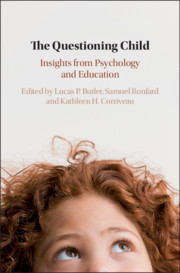Book contents
- The Questioning Child
- The Questioning Child
- Copyright page
- Dedication
- Contents
- Figures
- Tables
- Contributors
- 1 Questions about Questions
- 2 Questions in Development
- 3 The Point, the Shrug, and the Question of Clarification
- 4 The Quest for Comprehension and Learning
- 5 Children’s Question-Asking across Cultural Communities
- 6 The Development of Information-Requesting Gestures in Infancy and Their Role in Shaping Learning Outcomes
- 7 Developmental Changes in Question-Asking
- 8 Understanding Developmental and Individual Differences in the Process of Inquiry during the Preschool Years
- 9 “Why Are There Big Squares and Little Squares?”
- 10 Children’s Questions in Social and Cultural Perspective
- 11 Mothers’ Use of Questions and Children’s Learning and Language Development
- 12 Teaching and Learning by Questioning
- 13 Asking “Why?” and “What If?”
- 14 What Makes a Good Question? Towards an Epistemic Classification
- 15 The Questioning Child
- Index
- References
6 - The Development of Information-Requesting Gestures in Infancy and Their Role in Shaping Learning Outcomes
Published online by Cambridge University Press: 10 January 2020
- The Questioning Child
- The Questioning Child
- Copyright page
- Dedication
- Contents
- Figures
- Tables
- Contributors
- 1 Questions about Questions
- 2 Questions in Development
- 3 The Point, the Shrug, and the Question of Clarification
- 4 The Quest for Comprehension and Learning
- 5 Children’s Question-Asking across Cultural Communities
- 6 The Development of Information-Requesting Gestures in Infancy and Their Role in Shaping Learning Outcomes
- 7 Developmental Changes in Question-Asking
- 8 Understanding Developmental and Individual Differences in the Process of Inquiry during the Preschool Years
- 9 “Why Are There Big Squares and Little Squares?”
- 10 Children’s Questions in Social and Cultural Perspective
- 11 Mothers’ Use of Questions and Children’s Learning and Language Development
- 12 Teaching and Learning by Questioning
- 13 Asking “Why?” and “What If?”
- 14 What Makes a Good Question? Towards an Epistemic Classification
- 15 The Questioning Child
- Index
- References
Summary
Human infants are remarkable learners. Although they are born with very limited knowledge about the world around them, by the end of the second year of life they demonstrate highly sophisticated reasoning abilities and a robust understanding of the physical and social world. Despite recent discoveries in what infants know, important questions still exist surrounding how they come to know it. In this chapter, I explore one mechanism that spurs early learning – a drive to seek out information through preverbal gestures. To do so, I first review the evidence for information seeking during infancy (e.g. attentional biases). I then turn to infants’ understanding of adults as rich sources of information, and describe how infants transition from attending to information to explicitly seeking it out. Here, I propose that long before infants acquire the verbal abilities to ask questions, they point to request information. I then argue that interrogative pointing plays a direct role in learning, with a specific focus on the link between pointing and word learning. I conclude with an exploration of infants’ transition from preverbal to verbal information requesting through question asking.
- Type
- Chapter
- Information
- The Questioning ChildInsights from Psychology and Education, pp. 89 - 117Publisher: Cambridge University PressPrint publication year: 2020
References
- 3
- Cited by

